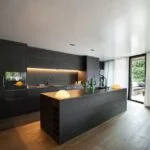Are you looking to infuse your home with the timeless charm of a Cape Cod aesthetic? If so, you’ve come to the right place.
In this article, we will explore how to decorate a Cape Cod home, from understanding the architectural style to incorporating nautical decor and natural materials. Whether you live in a traditional Cape Cod-style house or simply admire its classic features, these tips will help you capture the essence of coastal New England in your own living space.
When it comes to decorating a Cape Cod home, it’s essential to have a thorough understanding of the architectural style that defines this iconic look. From its origins as a response to harsh weather conditions on the Massachusetts coastline, Cape Cod homes have evolved into a beloved design aesthetic that emphasizes simplicity, functionality, and a connection to nature. Understanding these principles will be key in achieving an authentic and cohesive Cape Cod-inspired interior.
One of the key elements of any Cape Cod home is its color palette. Choose colors that evoke the serene beauty of the coast, such as shades of blue, white, beige, and soft pastels. These hues create a calming and airy atmosphere that is characteristic of Cape Cod style.
Additionally, incorporating nautical and beach-inspired decor elements can further enhance the coastal vibe of your home. Whether through artwork, accessories or textiles, infusing your space with subtle nods to the sea will complete the look. Stay tuned as we delve deeper into these topics throughout this article.
Choosing a Color Palette That Fits the Cape Cod Aesthetic
When it comes to decorating a Cape Cod home, choosing the right color palette is essential in capturing the aesthetic of this architectural style. The Cape Cod aesthetic is all about creating a light, airy, and timeless feel, so it’s important to select colors that reflect these characteristics. Typically, Cape Cod homes feature a neutral color scheme with soft, calming hues inspired by the surrounding coastal environment.
Some popular color choices for Cape Cod interiors include shades of white, cream, beige, and light gray. These colors help to create a sense of serenity and openness while also allowing natural light to penetrate the space. Additionally, incorporating soft blues and greens can evoke a nautical and beach-inspired theme that is often associated with Cape Cod decor.
It’s important to note that while neutral colors dominate the Cape Cod aesthetic, adding subtle pops of color can bring visual interest and dimension to the space. This can be achieved through the use of accent pillows, throws, artwork, or decorative accessories. By sticking to a predominantly neutral palette with hints of soft pastels or muted tones, you can achieve a cohesive and harmonious look that embodies the essence of Cape Cod style.
| Color Palette | Examples |
|---|---|
| Neutral Colors | White, Cream, Beige |
| Nautical Inspired Hues | Soft Blues and Greens |
| Accent Colors | Muted Tones or Soft Pastels |
Incorporating Nautical and Beach-Inspired Decor
When it comes to decorating a Cape Cod home, incorporating nautical and beach-inspired decor is essential to achieving an authentic coastal aesthetic. This style often includes elements such as seashells, driftwood, anchors, and sailboats. These items can be displayed as standalone decorations or incorporated into functional pieces such as lamps, mirrors, or wall art. Additionally, using marine colors like navy blue, white, and various shades of beige can help create a cohesive look throughout the space.
One way to bring the beach indoors is by using natural textures such as sisal rugs, jute baskets, and wicker furniture. These materials not only add visual interest to the room but also evoke a sense of casual relaxation commonly associated with coastal living. Furthermore, using lightweight fabrics like cotton and linen for curtains and upholstery can help enhance the breezy atmosphere that is characteristic of Cape Cod decor.
Another key element in incorporating nautical and beach-inspired decor is to display artwork featuring ocean scenes or maritime themes. Whether it’s a painting of crashing waves or a photograph of a lighthouse, these pieces can serve as focal points in the room while emphasizing the home’s connection to its coastal surroundings. By incorporating these design elements thoughtfully, homeowners can create an inviting and refreshing space that reflects the charm of Cape Cod style.
| Element | Description |
|---|---|
| Color Palette | Navy blue, white, beige |
| Textures | Sisal rugs, jute baskets, wicker furniture |
| Artwork | Ocean scenes, maritime themes |
Utilizing Natural Materials Such as Wood, Wicker, and Linen
When it comes to decorating a Cape Cod home, natural materials play a significant role in capturing the essence of this architectural style. Incorporating elements such as wood, wicker, and linen can help create a warm and inviting atmosphere that is characteristic of Cape Cod decor. These materials not only add texture and depth to the space but also enhance the overall aesthetic appeal.
Wood is a popular choice for furniture, flooring, and even architectural details in Cape Cod homes. Whether it’s exposed ceiling beams, shiplap walls, or hardwood floors, the use of natural wood adds a sense of authenticity and rustic charm to the interior.
Wicker furniture and accessories, such as baskets and decorative accents, further contribute to the coastal vibe while providing a casual and relaxed feel to the space. Additionally, incorporating linen upholstery for sofas, chairs, and curtains can bring a sense of airiness and lightness to the room.
To achieve an authentic Cape Cod look, it’s important to carefully select natural materials that evoke a sense of coastal living while maintaining a comfortable and cozy ambiance throughout the home. Whether through furniture pieces or decorative accessories, incorporating wood, wicker, and linen into your design scheme will help you achieve the timeless appeal of Cape Cod style in your home.
Embracing a Cozy and Comfortable Atmosphere
When it comes to decorating a Cape Cod home, creating a cozy and comfortable atmosphere is essential. This style embodies a sense of warmth and relaxation, making it an inviting and welcoming space for both residents and guests.
Use of Soft Textures
Incorporating soft textures is key to achieving a cozy ambiance in a Cape Cod home. Look for furnishings and decor pieces made from plush fabrics such as cotton, wool, or chenille. Cozy throw blankets, area rugs, and decorative pillows can also add tactile comfort to the space.
Warm Lighting
Lighting plays a significant role in setting the right mood for a cozy atmosphere. Opt for warm-toned light bulbs that emit soft, ambient lighting. Consider using table lamps, floor lamps, and sconces to create a layered lighting effect that adds depth and coziness to the room.
Fireplace Feature
If your Cape Cod home includes a fireplace, make it the focal point of the room by arranging seating around it. A crackling fire adds both literal and visual warmth to space, enhancing its cozy ambiance during colder months.
By focusing on soft textures, warm lighting, and utilizing fireplace features, you can effectively embrace a cozy and comfortable atmosphere in your Cape Cod home. These elements contribute to creating a relaxing environment that is characteristic of this timeless architectural style.
Highlighting the Use of Natural Light and Spacious Layouts
The Cape Cod architectural style is known for its emphasis on natural light and spacious layouts. This design approach prioritizes creating a bright and airy atmosphere, which reflects the serene and relaxed coastal lifestyle. To achieve this look in your Cape Cod home, it’s essential to maximize the use of natural light and embrace open, uncluttered spaces.
Maximizing Natural Light
One of the key elements of decorating a Cape Cod home is to make the most of natural light. This can be achieved by incorporating large windows that allow sunlight to flood into the space. Additionally, consider using sheer curtains or window treatments that do not obstruct light, while still providing some level of privacy. Mirrors can also be strategically placed to reflect light and create the illusion of a larger, brighter space.
Creating Open and Airy Layouts
Spacious layouts are another hallmark of Cape Cod design. To achieve this in your home, opt for minimalistic furniture arrangements that allow for easy movement and flow within each room. Avoid overcrowding the space with too many pieces of furniture or decor items. Emphasize clean lines and open spaces to create an uncluttered and relaxing environment throughout your home.
By prioritizing natural light and spacious layouts in your decorating approach, you can effectively capture the essence of Cape Cod style in your home. These principles not only contribute to the aesthetic appeal but also promote a sense of tranquility and comfort, making your living spaces inviting and cozy for both residents and guests alike.
Adding Vintage and Antique Accents for a Timeless Feel
When it comes to decorating a Cape Cod home, adding vintage and antique accents is essential for achieving a timeless feel. Incorporating these elements not only adds character and charm to the space but also pays homage to the rich history of Cape Cod architecture and design.
Here are some tips for incorporating vintage and antique accents in your Cape Cod home:
- Visit local flea markets, antique shops, and estate sales to find unique pieces with a sense of history and patina.
- Look for traditional Cape Cod furniture styles such as ladder-back chairs, Windsor chairs, and other classic pieces that reflect the region’s colonial heritage.
- Display vintage nautical maps, ship wheels, or weathered sea-themed artwork to evoke the maritime history of Cape Cod.
In addition to furniture and decor items, you can also incorporate vintage elements into architectural details such as reclaimed wood beams, salvaged doors, or stained glass windows. By mixing old and new elements, you can create a space that feels both timeless and welcoming. Remember that the key is not to overwhelm the space with too many vintage pieces; instead, aim for a curated collection that tells a story and adds warmth to your Cape Cod home.
Tips for Incorporating Cape Cod Style in Every Room of the Home
When it comes to incorporating Cape Cod style in every room of the home, there are several key elements to keep in mind. Whether you’re decorating the living room, bedroom, kitchen, or bathroom, here are some tips to help you achieve the classic Cape Cod aesthetic:
- Choose a soft and neutral color palette for the walls, such as white, beige, light blue, or gray. These colors will help create a bright and airy atmosphere that is characteristic of Cape Cod style.
- Incorporate nautical and beach-inspired decor throughout the home. This can include items such as seashells, driftwood, ropes, anchors, and artwork featuring coastal landscapes.
- Utilize natural materials like wood, wicker, and linen in your furniture and decor choices. These elements add warmth and texture to the space while maintaining a relaxed and casual feel.
Additionally, it’s important to embrace a cozy and comfortable atmosphere in every room. Plush sofas and chairs with slipcovers, soft throw blankets, and plush area rugs can all contribute to this inviting vibe.
Finally, aim for simplicity and minimalism in your decor choices. Avoid cluttering rooms with unnecessary items and instead focus on showcasing a few well-chosen pieces that reflect the timeless appeal of Cape Cod style. By following these tips, you can infuse your entire home with the charm and elegance of this beloved architectural aesthetic.
The Importance of Simplicity and Minimalism in Cape Cod Decor
In conclusion, decorating a Cape Cod home is all about embracing simplicity and minimalism. By understanding the architectural style and choosing a fitting color palette, incorporating nautical decor, utilizing natural materials, and creating a cozy atmosphere, homeowners can achieve the timeless and classic Cape Cod look. It’s important to remember that less is more when it comes to this style; clutter should be avoided and every piece of decor should have a purpose.
The use of natural light and spacious layouts are essential components of Cape Cod decor, as they contribute to the overall airy and open feel of the space. Vintage and antique accents can add character and charm to the home, while maintaining the cohesive aesthetic. From the living room to the bedroom, every room in the house can embody Cape Cod style with the right approach to decoration.
Ultimately, embracing simplicity and minimalism in Cape Cod decor allows for an elegant and tranquil living space. By following these tips and staying true to the core principles of this design style, homeowners can create a welcoming retreat that reflects the timeless beauty of Cape Cod architecture.
Frequently Asked Questions
How Do You Style a Cape Cod Home?
Styling a Cape Cod home involves embracing its traditional and classic design elements. This includes using a crisp white color palette for the exterior, adding dormer windows, and using natural materials such as wood and shingle siding.
Inside, focusing on creating a cozy and inviting atmosphere with simple furnishings, neutral colors, and nautical-themed decor can help capture the Cape Cod style.
What Makes a House a Cape Cod House?
A Cape Cod house is typically characterized by its symmetrical design, steep roof with side gables, central front door with multi-paned windows on either side, and often includes dormer windows. These homes are usually one to one-and-a-half stories high and have a simple, rectangular shape.
The use of natural materials like wood shingles or clapboard siding adds to the traditional look of a Cape Cod house.
What Are Cape Cod Colors?
Cape Cod colors often reflect the coastal environment that the region is known for. This can include a range of blues from soft sky blue to deep navy, sandy beiges and whites reminiscent of beach sand and seashells, soft grays like weathered driftwood, and hints of green inspired by the area’s lush foliage.
These colors evoke a sense of tranquility and calmness while reflecting the natural beauty of Cape Cod’s landscape.

I’m thrilled to be your companion on this exciting journey through the world of home decor and design. With a passion for turning houses into homes and a keen eye for the finer details, I’m here to help you transform your living spaces into beautiful, functional, and meaningful havens.





